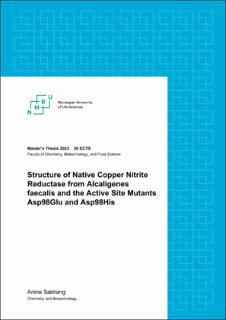| dc.description.abstract | Copper-dependent nitrite reductase from Alcaligenes faecalis (Cu-AfNiR) is an enzyme that catalyzes the reduction of nitrite into nitric oxide. A highly conserved residue, Asp98, in the Type-2 Cu active site, is the proton donor in this reaction. Mutating this residue may cause a shift in the activity of the enzyme, enabling it to reduce other small molecule substrates.
In this thesis, Asp98 has been mutated to Glu and His, respectively, resulting in the Cu-AfNiR D98E and Cu-AfNiR D98H mutants. The D98E mutant repositions the carboxyl group that acts as an acid/base catalyst in the active site and the D98H both repositions and alters the pKa of the active site acid/base catalyst. Also, other uncharacterized NiR variants in nature display glutamate and histidine in the Asp98 position. Crystals of the enzymes were soaked in formate to bind formate in the active site. Formate is a possible product in the reduction of CO2, a small molecule substrate of high interest. The enzymes were also soaked in reducing conditions. The WT and mutants have all been structurally determined by X-ray diffraction. The binding of the transition metals Ni and Co which have different redox properties than Cu was also considered.
Glu98 and His98 both coordinated the Cu atom in the Type- 2 Cu active site in the mutated enzymes. This created new active sites of Cu-AfNiR, with possible changes in the function of the enzyme. The oxidized Cu-AfNiR WT was the only structure where formate would bind in the active site. The reduction of the enzymes was not fully successful, even with two different
methods for reducing the crystals.
Mutating the highly conserved Asp98 in the active site of Cu-AfNiR changes the structure, causing the enzyme to not bind formate in the active site as the WT is able to do. This may have implications for the activity of the enzyme. An activity assay of the mutants would determine if they were inhibited from the nitrite reduction, and or are able to catalyze other reactions. A new method of reducing the crystals is also needed, as they were not fully reduced. | |
